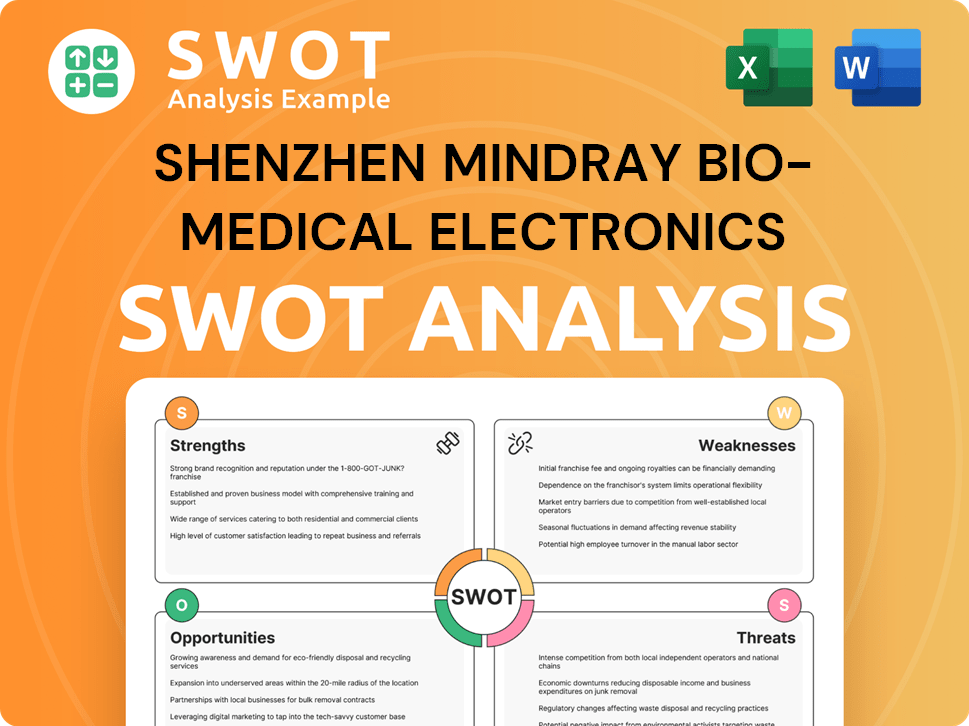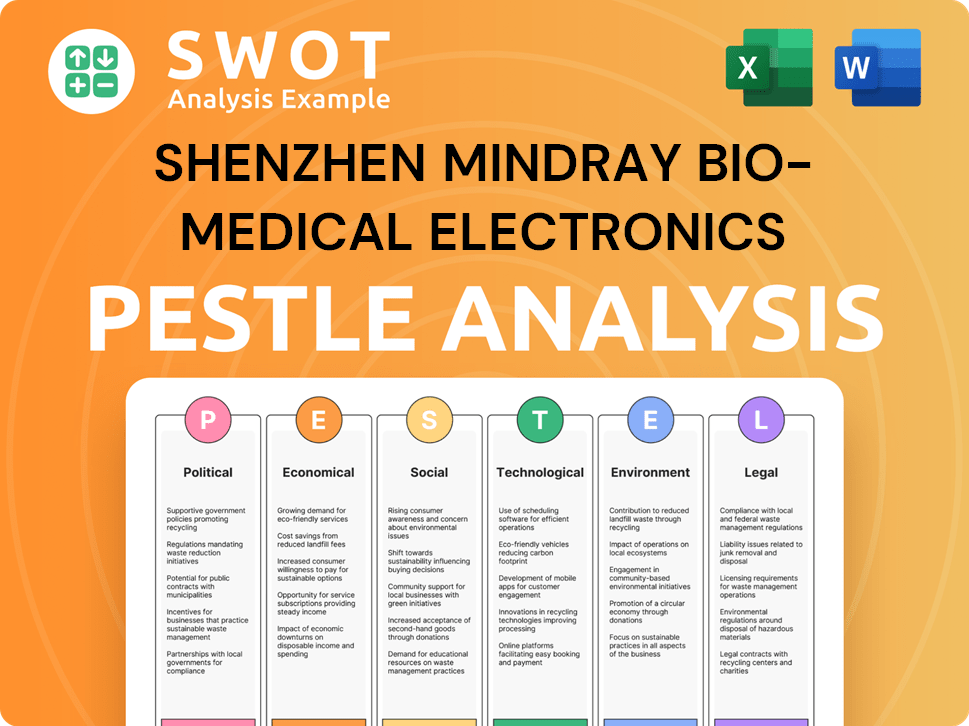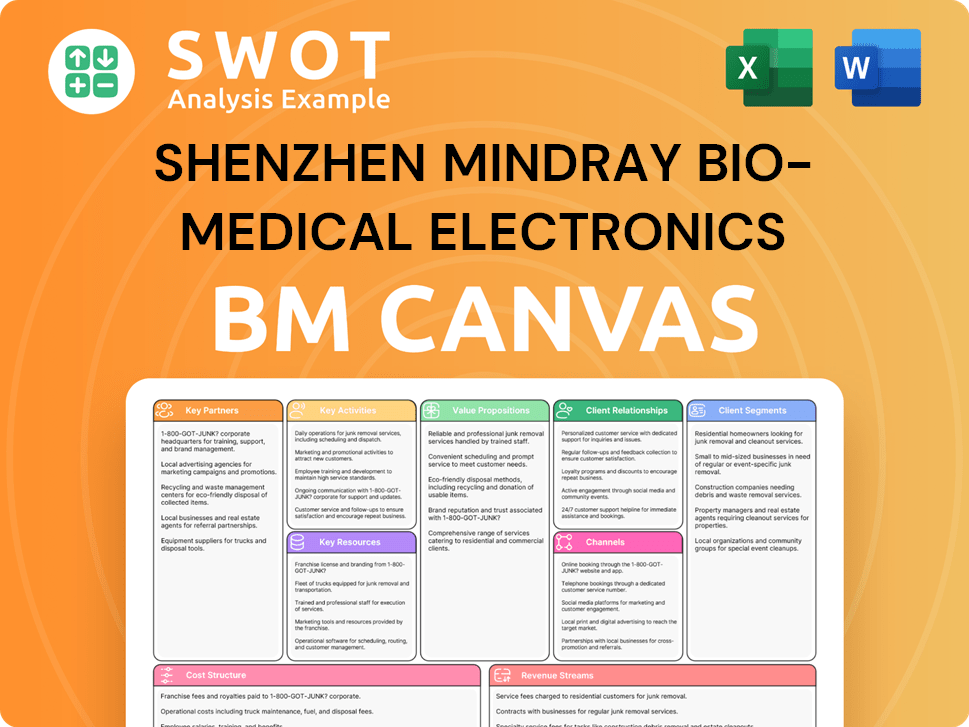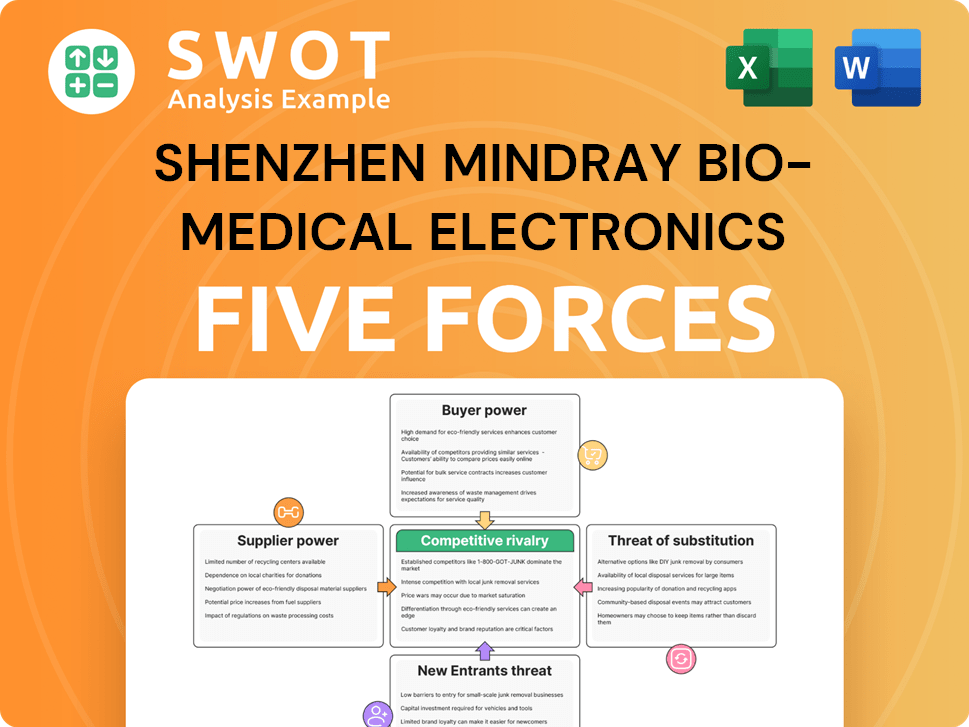Shenzhen Mindray Bio-Medical Electronics Bundle
Can Shenzhen Mindray Bio-Medical Conquer the Global Medical Device Market?
The medical device market is a battlefield of innovation and competition, and Shenzhen Mindray Bio-Medical Electronics Company has emerged as a major player. From its humble beginnings in China, Mindray has rapidly expanded its global footprint, challenging established industry giants. Understanding the Shenzhen Mindray Bio-Medical Electronics SWOT Analysis is crucial to grasping its competitive position.

This analysis delves into the Mindray competitive landscape, exploring its key rivals and the strategies that fuel its success. We'll examine Mindray Bio-Medical's journey, from its initial focus on patient monitoring to its current dominance in in vitro diagnostics and medical imaging. This exploration provides critical insights for anyone seeking to understand Mindray's position in China's medical device market and its global ambitions, including its competitive edge against major Mindray competitors.
Where Does Shenzhen Mindray Bio-Medical Electronics’ Stand in the Current Market?
Shenzhen Mindray Bio-Medical Electronics (Mindray) holds a strong market position in the global medical device industry, particularly in its core segments. The company is recognized as a leading provider of medical devices and solutions in China and has significantly expanded its international presence. Mindray's competitive landscape is shaped by its comprehensive product portfolio and strategic global expansion efforts.
Mindray's core operations revolve around three primary product lines: patient monitoring and life support, in-vitro diagnostics (IVD), and medical imaging systems. The company's value proposition lies in providing innovative, high-quality, and cost-effective medical solutions. This approach has enabled Mindray to capture significant market share and maintain a competitive edge in the dynamic medical device market.
In 2023, Mindray reported a total revenue of approximately 34.93 billion RMB (around $4.82 billion USD), reflecting a 14.88% year-over-year increase. This growth underscores the company's robust financial health and scale within the medical device market. Mindray's strategic focus on research and development, with R&D expenses reaching 3.76 billion RMB in 2023, representing 10.76% of its operating revenue, further solidifies its commitment to innovation and competitive advantage.
Mindray's revenue is primarily derived from three key segments: patient monitoring and life support, in-vitro diagnostics (IVD), and medical imaging systems. The IVD segment accounted for 39.5% of Mindray's revenue in 2023, growing by 19.3% year-over-year, showcasing its significant contribution to the company's overall performance. The other segments also contribute significantly to the company's revenue stream.
Mindray has a strong presence in over 190 countries and regions, with notable growth in international markets. In 2023, international revenue reached 13.91 billion RMB, growing by 20.57% year-over-year. This reflects a strategic shift towards increasing its global market share beyond its domestic stronghold. The company is expanding its reach to serve a global customer base.
Mindray serves a wide range of customer segments, from large hospitals to smaller clinics, providing a comprehensive suite of solutions. This diverse customer base allows Mindray to maintain a stable revenue stream and adapt to various market demands. The company's ability to cater to different customer needs is a key factor in its market position.
Mindray consistently invests in research and development, with R&D expenses reaching 3.76 billion RMB in 2023, representing 10.76% of its operating revenue. This investment underscores its commitment to innovation and maintaining a competitive edge in the medical device market. This commitment is crucial for its long-term success.
Mindray's strategic advantages include a strong brand reputation, a comprehensive product portfolio, and a global distribution network. The company's focus on innovation and customer service further enhances its market position. These factors contribute to its sustained growth and competitive edge in the medical device market, as highlighted in the Growth Strategy of Shenzhen Mindray Bio-Medical Electronics.
- Strong brand recognition and reputation.
- Comprehensive product portfolio covering multiple segments.
- Global distribution network and international expansion.
- Consistent investment in research and development.
Shenzhen Mindray Bio-Medical Electronics SWOT Analysis
- Complete SWOT Breakdown
- Fully Customizable
- Editable in Excel & Word
- Professional Formatting
- Investor-Ready Format

Who Are the Main Competitors Challenging Shenzhen Mindray Bio-Medical Electronics?
The Mindray competitive landscape is shaped by a diverse array of global and regional players across its product segments. Shenzhen Mindray Bio-Medical Electronics Company faces significant competition in the medical device market, particularly in patient monitoring, in-vitro diagnostics (IVD), and medical imaging.
Understanding the Mindray competitors and their strategies is crucial for assessing Mindray's market position and future growth prospects. This analysis considers key players, their strengths, and how they challenge Mindray across different segments.
In the patient monitoring and life support sector, Mindray Bio-Medical competes with established companies like Philips, GE HealthCare, and Draeger. These competitors offer comprehensive product portfolios and strong brand recognition.
Philips and GE HealthCare are major players with extensive global distribution networks. They provide advanced technology and have strong relationships with healthcare providers, posing a significant challenge to Mindray.
Draeger, though smaller, is known for high-quality anesthesia workstations and critical care solutions. They focus on specialized solutions within the patient monitoring and life support market.
In the in-vitro diagnostics (IVD) market, Mindray Bio-Medical competes with global giants like Roche Diagnostics, Abbott Laboratories, Siemens Healthineers, and Danaher Corporation.
These companies offer a broad range of IVD instruments and reagents, often focusing on high-throughput systems and specialized diagnostics. Their strengths include extensive test menus and global supply chains.
Chinese domestic competitors also pose a challenge in the IVD space, frequently offering more cost-effective solutions, increasing the competitive pressure on Mindray.
For medical imaging systems, Mindray competes with GE HealthCare, Siemens Healthineers, Philips, and Canon Medical Systems. These companies are leaders in various imaging modalities and possess advanced imaging technologies.
Mindray often competes by offering high-performance systems at a more competitive price point, particularly in emerging markets. The Mindray competitive landscape is influenced by new entrants specializing in AI-powered diagnostics and portable medical devices.
- Mergers and acquisitions reshape the market, consolidating market power.
- Mindray continues to invest in research and development to enhance its product offerings.
- Strategic partnerships are crucial for expanding market reach and technological capabilities.
- Regulatory compliance and market access are critical factors for success.
Shenzhen Mindray Bio-Medical Electronics PESTLE Analysis
- Covers All 6 PESTLE Categories
- No Research Needed – Save Hours of Work
- Built by Experts, Trusted by Consultants
- Instant Download, Ready to Use
- 100% Editable, Fully Customizable

What Gives Shenzhen Mindray Bio-Medical Electronics a Competitive Edge Over Its Rivals?
The competitive landscape for Shenzhen Mindray Bio-Medical Electronics (Mindray) is shaped by its strategic focus on innovation, cost-effectiveness, and global expansion. Mindray's commitment to research and development, as evidenced by its substantial R&D spending, fuels its ability to introduce cutting-edge medical devices. This focus allows it to maintain a strong position within the medical device market.
Mindray's strategy includes offering high-quality products at competitive prices, particularly in emerging markets. This approach, combined with a comprehensive product portfolio and a strong global distribution network, has enabled rapid market penetration. The company's ability to provide integrated solutions enhances customer loyalty and supports sustainable growth.
Mindray's competitive advantages are further bolstered by its efficient manufacturing processes and a responsive supply chain. These operational efficiencies contribute to better cost control and quicker responses to market demands. The company's focus on strategic market expansion and continuous investment in R&D supports the sustainability of these advantages, even amidst challenges from competitors and regulatory changes.
Mindray's significant investment in research and development is a cornerstone of its competitive strategy. In 2023, R&D expenses reached 3.76 billion RMB, reflecting a commitment to innovation. This investment allows Mindray to develop proprietary technologies and secure intellectual property, differentiating its offerings in the medical device market.
Offering high-quality medical devices at competitive prices is a key advantage, especially in emerging markets. This cost-effectiveness has facilitated rapid market penetration in developing countries. Mindray's strategy allows it to compete effectively with established players in the medical device market.
Mindray's comprehensive product portfolio spans patient monitoring, in vitro diagnostics (IVD), and medical imaging. This allows the company to provide integrated solutions to healthcare facilities. Offering a wide range of products fosters customer loyalty and reduces reliance on multiple vendors.
A strong global presence is crucial for Mindray's success. With operations in over 190 countries and regions, Mindray has established robust channels for sales, marketing, and after-sales support. This extensive reach ensures its products are accessible to a wide range of customers worldwide.
Mindray's agile manufacturing processes and efficient supply chain contribute to its operational efficiencies, enabling quicker responses to market demands. The company's strategic market expansion further strengthens its competitive position, supported by continuous investment in R&D. For more insights, see the Growth Strategy of Shenzhen Mindray Bio-Medical Electronics article.
- Mindray's revenue growth has been consistently strong, reflecting its effective strategies.
- The company's focus on emerging markets has driven significant international revenue.
- Strategic partnerships and acquisitions have expanded Mindray's product offerings and market reach.
- Mindray faces challenges from aggressive competitors, requiring continuous innovation and adaptation.
Shenzhen Mindray Bio-Medical Electronics Business Model Canvas
- Complete 9-Block Business Model Canvas
- Effortlessly Communicate Your Business Strategy
- Investor-Ready BMC Format
- 100% Editable and Customizable
- Clear and Structured Layout

What Industry Trends Are Reshaping Shenzhen Mindray Bio-Medical Electronics’s Competitive Landscape?
The medical device industry is undergoing significant transformations, creating both challenges and opportunities for companies like Shenzhen Mindray Bio-Medical Electronics. Technological advancements, regulatory changes, and global economic shifts are key factors shaping the competitive landscape. Understanding these trends is crucial for assessing Mindray's position and future prospects in the market.
Mindray's competitive landscape is influenced by its product portfolio, market share, and financial performance. A comprehensive analysis requires examining its position in the medical device market, including in vitro diagnostics and ultrasound machines. The company faces competition from both established global players and emerging local competitors. The analysis should also consider Mindray's strategic partnerships, research and development investments, and recent acquisitions.
Technological advancements, especially in AI, big data, and cloud computing, are driving innovation in medical diagnostics and treatment. Regulatory changes, including those related to data privacy and product approvals, are increasing compliance demands. Global economic shifts, such as inflation and supply chain disruptions, impact manufacturing and distribution.
Intensifying competition from well-resourced Western companies and cost-effective local competitors poses a threat. Adapting to the growing demand for personalized medicine and point-of-care testing is essential. Geopolitical tensions and trade policies can impact the supply chain and market access. The company must navigate these challenges to maintain its market position.
Emerging markets offer significant growth potential due to expanding healthcare infrastructure and growing populations. Continued investment in product innovations, especially in areas like robotic surgery and advanced in-vitro diagnostics, could open new revenue streams. Strategic partnerships and acquisitions can enhance technological capabilities and market reach.
Embracing digital transformation and focusing on integrated solutions can strengthen Mindray's competitive position. Investing in research and development to stay ahead of technological advancements is crucial. Expanding market presence through strategic partnerships and acquisitions is also important. The company needs to focus on these areas to succeed.
Mindray's ability to adapt to technological advancements, such as AI-powered diagnostics, is critical. The company must navigate the complexities of global regulatory environments, ensuring compliance with data privacy and product approval standards. Strategic decisions regarding market expansion, partnerships, and acquisitions will significantly impact its future success. The company needs to focus on Target Market of Shenzhen Mindray Bio-Medical Electronics to maintain its market position.
- Market Dynamics: The global medical device market was valued at approximately $508 billion in 2023 and is projected to reach $718 billion by 2028, growing at a CAGR of 7.2% from 2023 to 2028.
- Competitive Landscape: Mindray faces competition from companies like GE Healthcare, Siemens Healthineers, and Philips. In 2024, GE Healthcare's revenue was about $20 billion.
- Technological Advancements: The integration of AI in medical devices is rapidly increasing. The AI in medical imaging market is expected to reach $5.7 billion by 2027.
- Regulatory Compliance: Stricter regulations, such as those from the FDA and EU MDR, are increasing compliance costs for medical device manufacturers.
Shenzhen Mindray Bio-Medical Electronics Porter's Five Forces Analysis
- Covers All 5 Competitive Forces in Detail
- Structured for Consultants, Students, and Founders
- 100% Editable in Microsoft Word & Excel
- Instant Digital Download – Use Immediately
- Compatible with Mac & PC – Fully Unlocked

Related Blogs
- What are Mission Vision & Core Values of Shenzhen Mindray Bio-Medical Electronics Company?
- What is Growth Strategy and Future Prospects of Shenzhen Mindray Bio-Medical Electronics Company?
- How Does Shenzhen Mindray Bio-Medical Electronics Company Work?
- What is Sales and Marketing Strategy of Shenzhen Mindray Bio-Medical Electronics Company?
- What is Brief History of Shenzhen Mindray Bio-Medical Electronics Company?
- Who Owns Shenzhen Mindray Bio-Medical Electronics Company?
- What is Customer Demographics and Target Market of Shenzhen Mindray Bio-Medical Electronics Company?
Disclaimer
All information, articles, and product details provided on this website are for general informational and educational purposes only. We do not claim any ownership over, nor do we intend to infringe upon, any trademarks, copyrights, logos, brand names, or other intellectual property mentioned or depicted on this site. Such intellectual property remains the property of its respective owners, and any references here are made solely for identification or informational purposes, without implying any affiliation, endorsement, or partnership.
We make no representations or warranties, express or implied, regarding the accuracy, completeness, or suitability of any content or products presented. Nothing on this website should be construed as legal, tax, investment, financial, medical, or other professional advice. In addition, no part of this site—including articles or product references—constitutes a solicitation, recommendation, endorsement, advertisement, or offer to buy or sell any securities, franchises, or other financial instruments, particularly in jurisdictions where such activity would be unlawful.
All content is of a general nature and may not address the specific circumstances of any individual or entity. It is not a substitute for professional advice or services. Any actions you take based on the information provided here are strictly at your own risk. You accept full responsibility for any decisions or outcomes arising from your use of this website and agree to release us from any liability in connection with your use of, or reliance upon, the content or products found herein.